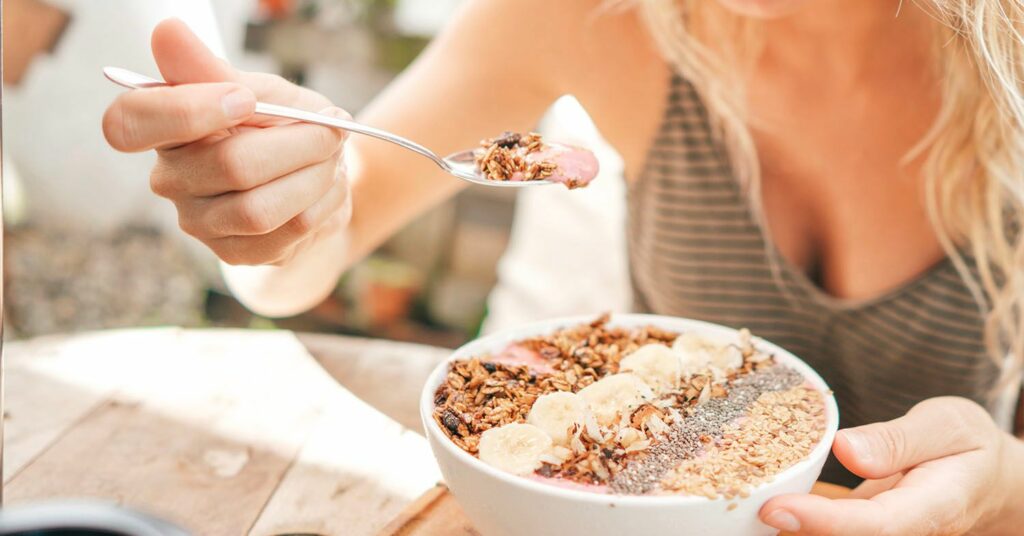Irritable bowel syndrome (IBS), a condition that affects the digestive system, impacts millions of people around the world. In the U.S. alone, between 2.4 million and 3.5 million people visit the doctor every year because of it. But what is the best way to manage the condition? Many experts recommend initially following a low FODMAP diet. Read on to find out more about IBS, as well as what the low FODMAP diet is and the vegan foods you can eat while following it.
What Is IBS?
IBS affects your colon, otherwise known as the large intestine. The condition causes your intestinal muscles to contract and relax uncontrollably, this is called spasming.
According to Cedars Sinai, a non-profit LA-based hospital, some experts think that people with IBS have a colon or small intestine that is highly sensitive; it can be affected by certain foods or by chronic stress, but the causes vary from person to person.
While IBS isn’t life-threatening, its symptoms, which include bloating, diarrhea, and muscle cramps, can cause significant levels of discomfort and pain. For some IBS sufferers, the cramps are so severe, they can end up in the hospital convinced they have something far more serious, like appendicitis. (For this reason, it’s always best to get symptoms checked out, as appendicitis is life-threatening.)
But there are ways to control IBS and ease up the symptoms. Changes to diet and keeping stress levels down can help, and in some cases, medication is advised. If you think you are suffering from IBS, make an appointment to visit your doctor to find out more about the best course of treatment for you.

What is a low FODMAP diet?
The recommended diet for some IBS sufferers is low FODMAP, which stands for Fermentable Oligosaccharides, Disaccharides, Monosaccharides, and Polyols.
Martha Gonzalez RD, LD, CLC writes for Blanchard Valley Health System: “Basically, FODMAPs is an umbrella term that includes simple sugars that are poorly absorbed and rapidly fermented by the gut. What this means is that when you consume foods that are high in FODMAPs, once they get to the intestines, they draw in water, increasing gas production. This leads to the classic symptoms of IBS: bloating, pain, distension, constipation and/or diarrhea.”
On the low FODMAP diet, IBS sufferers avoid foods that are high in FODMAPs for a limited amount of time. They then slowly reintroduce foods back in to figure out which ones may be causing their digestive problems.
But remember: It’s important not to dramatically change your diet to treat a medical issue without seeking professional advice first.
What can you eat on a vegan, low FODMAP diet?
Lactose is a disaccharide, meaning that dairy products are to be avoided completely on the low FODMAP diet. Initially, this sounds like a vegan’s dream. However, there are also many vegetables and legumes which can cause IBS to flare up, including soybeans, cauliflower, and mushrooms, amongst others. Many fruits are also off limits and a lot of grains too.
But FODMAP Everyday notes it’s completely possible to ditch animal products and stick to the low FODMAP diet. It advises: “With a little planning and some expert guidance, successfully completing a low FODMAP Elimination Phase is completely attainable for someone who eats no meat…or no animal products whatsoever.”
Here are all the foods you can still enjoy from a variety of food groups on a plant-based low FODMAP diet:

Carbohydrates
The low FODMAP diet advises you to avoid a number of carbohydrate sources, including pastries, gnocchi, wheat noodles, multigrain bread, and crumpets. However, there are still a number of vegan-friendly carbs you can add to your diet. Gluten-free bread and pasta (the video above contains a delicious low FODMAP pasta recipe, by the way) are considered low FODMAP-friendly, as is rice flour, buckwheat, quinoa, oats, polenta, and potatoes. If you’re craving a snack, opt for popcorn or crisps.
Fruits & vegetables
You should avoid onions and garlic almost entirely on a low FODMAP diet, as well as cauliflower, celery, artichoke, asparagus, and fruits high in fructose, like apples and mangoes. Undeniably, the list of fruits and vegetables to avoid is extensive. However, it’s not all bad news. Bananas, blueberries, grapes, kiwis, oranges, pineapples, raspberries, strawberries, and coconuts are all still in the cards. Take them to work as a snack, make a dessert fruit salad, or blend into a breakfast smoothie.
To pack in the veggies, choose broccoli or carrots to accompany your dinner. On the former, only go for low amounts (less than one quarter of a cup is considered low FODMAP), and interesting fact: the broccoli head is better than the stalk, as the latter contains more FODMAPS than the former.
If neither broccoli or carrots interest you, you could try zucchini, butternut squash, cucumber, aubergine, lettuce, or red peppers.

Plant-Based protein
After removing meat, the protein section of a low FODMAP diet becomes quite small. However, there are still plant-based foods to choose from; drained and firm tofu is accepted on the diet, as is tempeh, and small amounts of chickpeas and lentils can also be consumed. And if you just want something easy and quick, Quorn products are also allowed on a low FODMAP diet.
Nuts, nut butters, and seeds
A variety of nuts and nut butters are perfectly acceptable on a low FODMAP diet, and they can provide you with protein, too. Hazelnuts, peanuts, and chestnuts all make the grade, as do brazil nuts, macadamia nuts, and walnuts. If seeds are more your snack of choice, there’s plenty on offer in this category too. Try chia, poppy, or pumpkin seeds, or opt for sunflower or sesame.
Oils
The low FODMAP diet allows a range of oils, including avocado, canola, coconut, and olive oil, as well as peanut, rice bran, soybean, vegetable, sunflower, and sesame varieties.

Plant-based milk
Dairy is a no-no if you’re following a low FODMAP diet, but almond milk is accepted, and so is hemp. If you’d like to try oat, that’s fine too, but it’s recommended you keep the serving at 30ml or below. For rice milk, it’s 200 ml or below.
Following a vegan, low FODMAP diet is within reach, and it may help you finally work out the cause of painful IBS symptoms. If you want to give it a go, book an appointment with your doctor or a nutritionist to talk through your options. It could take you one step closer to more cramp-free days.


